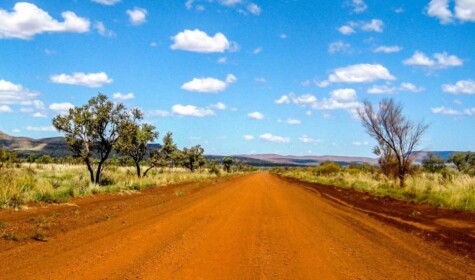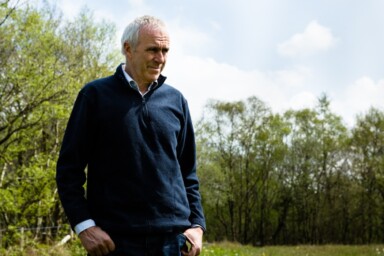Australia is home to a rich diversity of soils and landscapes that have been shaped under unique climatic and biological conditions for millennia. As in any country, Australia’s soils are one of its most valuable natural assets, critical to sustainable food production, biodiversity conservation, water quality and human health – but they are also among the most nutrient poor and unproductive in the world. A significant proportion of the cropland and pasture in Australia is affected by some form of soil degradation. As such, there are currently a number of adverse soil conditions that threaten the continent’s future food production, particularly in the face of a changing climate. It is precisely these agricultural challenges and the country’s unique food production environment, however, that have given rise to world-leading innovations for regenerative landscape management.
A land of sweeping plains
Australia defines itself by the uniqueness of its landscapes – its wetlands, forests, tropical hinterlands, deserts, and also its oceans, which are home to a wide variety of native flora and fauna that cannot be found anywhere else on the planet. Land management strategies have been practised in Australia in differing forms for many thousands of years. Aboriginal and Torres Strait Islander peoples significantly shaped and transformed the landscape through sustainable land management practices that increased plant nutrient availability, exposed game, regenerated vegetation and sustained a culture for tens of thousands of years. European colonisation and settlement, by contrast, caused extreme and extensive change by clearing native vegetation and forests, damming rivers, building urban centres and establishing intensive and increasingly industrialised agricultural systems over the last two and a half centuries.
In many regions across the continent today, the country’s soils – agricultural or otherwise – have been altered profoundly and are subject to increasing pressures. Rapid urban expansion and mining activities compete for prime agricultural land and affect a range of ecosystem services vital for sustainable soil management and health. Increased bushfire frequency, prolonged droughts, intense flooding and the prospect of rapid and ongoing climate-driven change have a range of biological impacts that are progressively changing and threatening Australian landscapes. These increasing pressures are raising important questions about the long-term sustainability of current land use practices and trends, particularly with regard to food production. At the same time, a large majority of Australian citizens and voters are located in conurbations, disconnected from their sources of food and fibre and the issues pertinent to their continuing sustainability and survival, rendering soil largely absent from political agendas and public discourse.
The state of Australian soils
Australian soils are typically older, more deeply weathered and less fertile than those of North America or Europe. As a result, many of the land degradation and soil management issues stem from the attempts to apply European farming methods, crop varieties and livestock breeds to distinctly Australian soils, landscapes and climates. While there are still areas of highly fertile soil, a significant proportion of both cropland and improved pasture is affected by acidification, salinisation, erosion, nutrient imbalance, structural decline, loss of organic matter (and consequently carbon) and other forms of degradation. This is currently causing environmental and economic concern in Australia.
Acidification, for example, currently affects 50 million hectares, or approximately half of Australia’s agriculturally productive soils, and is common in intensive agricultural systems such as tropical horticulture, monoculture sugar cane farming and dairying. Soil acidification can cause significant on-site and off-site damage, including accelerated leaching of plant nutrients, reduced carbon sequestration in soils and eutrophication in bodies of water. Acidification, often caused by the use of nitrogen fertilisers, can restrict land management options to acid-tolerant crop and vegetation varietals, and becomes more difficult and expensive to address as it advances into deeper layers of the soil.
Rates of land clearing and the removal of native vegetation for broadacre crop and livestock production is increasing in some Australian states, with direct impacts on soil health and carbon stores. Soil carbon can decrease between 20-70% of the pre-clearing amount, and – as 55% of Australia’s continental carbon store is contained in soils – can generate significant greenhouse gas emissions. Land clearing also diminishes the resilience of landscapes and ecosystems as native vegetation provides a range of environmental services, from stabilising soil to housing beneficial pollinators and animals.
The rate of soil erosion across much of Australia is at an unsustainable level, vastly exceeding the rate of soil formation. According to the most recent State of the Environment report, the expected half-life of soils – the time it takes for soil properties to decay to half their initial value – has declined to just decades in some agricultural areas. Long-term climate shifts could exacerbate this problem on two fronts: declining rainfall will likely produce less crop biomass and organic matter to protect soils, and flooding events are likely to be more intense, exacerbating erosion risk.
Indeed, climate change is the most serious threat to Australian agriculture and will likely make soil management more challenging in most agricultural regions. The many potential impacts of climate change – from regional shifts in climate patterns and species distribution to more intense floods, droughts and bushfires – will increase demands to change or relocate farming systems, placing new pressures on soils.
Overall, soil degradation imposes on- and off-farm problems that carry significant social, economic and environmental costs. In the face of an increasingly variable and harsher climate, a growing population and global demand for food, as well as declining water availability, the resilience of Australian agricultural systems is contingent upon the sustainable management and regeneration of its soils and landscapes.
Grassroots organisations
A significant number of groups and individual farmers have, however, been working to address these issues. Soils for Life (SfL) is an Australian organisation encouraging the adoption of “regenerative land management practices across rural and urban environments”. It does this by supporting farmers already practising regenerative agriculture, educating society about the benefits of improving soil health and advocating for a unified national policy approach to soil health.
SfL conducts field studies on farms practising regenerative agriculture, to provide case studies outlining which practices work and why. Over 20 case studies have been undertaken so far, and 100 more are in the pipeline, meaning that over 1 million hectares of Australian farm and range-land is under management designed to improve soil health. These case studies encompass livestock, arable, horticulture, viticulture, and urban agriculture. SfL also operates a mentoring programmedrawing on the experience of long-time practitioners, and the organisation campaigns to ensure that primary schools have working gardens and that children learn about soil science and the importance of soil health.
Another innovative venture that supports and enhances sustainable land management is the Organic and Regenerative Investment Co-operative (ORICoop). ORICoop aims to enable investment, management, education and growth opportunities across the Australian organic, regenerative, biodynamic and agroecological farming and food sectors. ORICoop works to acquire and preserve certified organic farmland in perpetuity for long-term, local and regenerative farming use. Investment criteria must be met by each property for its ongoing management, including practices that embrace agroecology principles and international organic standards as well as preserve soil resources, biodiversity and waterways. ORICoop also grants businesses across the organic supply chain the opportunity to seek funding to support regional economies, refugees and indigenous land managers through the preservation and growth of local food ecosystems throughout Australia.
There are also many other Australian initiatives helping regenerate agricultural soils on the continent and abroad. For example, the global permaculture movement, founded in Australia in the 1970s by Bill Mollison and David Holmgren, and more recent enterprises such as Carbon Link, Regenerative Australian Farmers and RegenAG all use innovative and traditional methods to build soil carbon, increase soil health and strengthen farmer livelihoods. These include planned grazing, biological fertiliser and the selective use of specific grasses, legumes, herbs, forbs and cereals. Through providing training and guidance on soil carbon measuring and management, holistic livestock management strategies and soil conservation and rehabilitation, each organisation works to support long-term sustainable soil management and increase agricultural resilience.
Government investments and world-class innovations
After almost 15 years of declining efforts and attention, the Australian Government has recently implemented the National Soil Research, Development and Extension Strategy and appointed a National Advocate for Soil Health to provide leadership and national strategic direction on Australia’s highest priority soil issues. Both work to increase collaboration between the research community and land managers to improve the availability, accessibility and quality of soil management information. The Advocate’s most recent report calls for the development of a comprehensive ‘National Soils Policy’ that “integrates soil, vegetation and water management to maintain and restore the health of Australia’s agricultural lands”. Acknowledging the role of farmers as stewards of Australia’s agricultural land, both the Advocate and Soil Strategy aim to identify, coordinate and address national soil priorities to better meet the needs of farmers, now and in the future.
Sustainable land management practices beyond agriculture also have positive impacts on biodiversity and ecosystem services, with benefits that transcend sectors and landscapes. The government-supported Indigenous Ranger and Indigenous Protected Area (IPA) programmes improve and rehabilitate Australia’s natural heritage across vast areas of land and sea. Indigenous owners enter a voluntary agreement with the Government to manage distinct bioregions: protecting biodiversity and threatened species, controlling feral animals and invasive weeds, managing burning regimes to avoid wildfires and conserving the area’s cultural and sacred resources. There are currently more than 70 dedicated IPAs in Australia across 67 million hectares, which accounts for more than 40% of the National Reserve System’s total area. Indigenous owners are often supported by scientists and other land managers, combining highly valuable traditional and local knowledge and contemporary science for the most effective land and sea management.
Australia is also home to innovations that are encouraging wider adoption of regenerative landscape management practices. The Biome of Australian Soil Environments (BASE), for example, is the first-ever programme to map soil biodiversity at a continental scale. Working with custodians and landowners, researchers have sampled soils from more than 1,500 sites across Australia and the Antarctic, spanning agricultural lands, tropics, deserts, alpine regions and coastal areas. By providing a publicly available reference map of the biological and functional diversity of Australia’s soil, BASE is a valuable tool for diverse users of environmental research and enhances their ability to achieve positive outcomes for agriculture and the environment.
Sustainable soil management: nationally important, globally critical
Worldwide, Australia is not alone in the need to address soil degradation and improve the resilience of its farming systems. Maintaining and improving soil health, restoring landscapes and protecting natural resources will require the development of land use systems that are tailored to Australia’s unique environmental attributes and contribute to global efforts in achieving land degradation neutrality. The pressures that influence land use and soil management involve a complex interplay of economic, social and environmental factors that will require a concerted and collaborative effort from government, business and civil society sectors to address them effectively. Long-term, strategic investment in soil rehabilitation is essential to building resilience is Australia’s agricultural sector and will play a key role in the nation’s response to the future challenges of food security, water availability and climate change.
Anyone interested in learning more about these issues could not do better than to read Charles Massy’s recently published, lyrical, moving and highly informative book, Call of the Reed Warbler; A New Agriculture, a New Earth, which includes an equally eloquent and powerful Foreword by Californian cattle rancher, Nicolette Hahn Niman.







